Pamela Mishkin
Contextual Confidence and Generative AI
Nov 02, 2023Abstract:Generative AI models perturb the foundations of effective human communication. They present new challenges to contextual confidence, disrupting participants' ability to identify the authentic context of communication and their ability to protect communication from reuse and recombination outside its intended context. In this paper, we describe strategies--tools, technologies and policies--that aim to stabilize communication in the face of these challenges. The strategies we discuss fall into two broad categories. Containment strategies aim to reassert context in environments where it is currently threatened--a reaction to the context-free expectations and norms established by the internet. Mobilization strategies, by contrast, view the rise of generative AI as an opportunity to proactively set new and higher expectations around privacy and authenticity in mediated communication.
GPTs are GPTs: An Early Look at the Labor Market Impact Potential of Large Language Models
Mar 23, 2023Abstract:We investigate the potential implications of large language models (LLMs), such as Generative Pre-trained Transformers (GPTs), on the U.S. labor market, focusing on the increased capabilities arising from LLM-powered software compared to LLMs on their own. Using a new rubric, we assess occupations based on their alignment with LLM capabilities, integrating both human expertise and GPT-4 classifications. Our findings reveal that around 80% of the U.S. workforce could have at least 10% of their work tasks affected by the introduction of LLMs, while approximately 19% of workers may see at least 50% of their tasks impacted. We do not make predictions about the development or adoption timeline of such LLMs. The projected effects span all wage levels, with higher-income jobs potentially facing greater exposure to LLM capabilities and LLM-powered software. Significantly, these impacts are not restricted to industries with higher recent productivity growth. Our analysis suggests that, with access to an LLM, about 15% of all worker tasks in the US could be completed significantly faster at the same level of quality. When incorporating software and tooling built on top of LLMs, this share increases to between 47 and 56% of all tasks. This finding implies that LLM-powered software will have a substantial effect on scaling the economic impacts of the underlying models. We conclude that LLMs such as GPTs exhibit traits of general-purpose technologies, indicating that they could have considerable economic, social, and policy implications.
Point-E: A System for Generating 3D Point Clouds from Complex Prompts
Dec 16, 2022Abstract:While recent work on text-conditional 3D object generation has shown promising results, the state-of-the-art methods typically require multiple GPU-hours to produce a single sample. This is in stark contrast to state-of-the-art generative image models, which produce samples in a number of seconds or minutes. In this paper, we explore an alternative method for 3D object generation which produces 3D models in only 1-2 minutes on a single GPU. Our method first generates a single synthetic view using a text-to-image diffusion model, and then produces a 3D point cloud using a second diffusion model which conditions on the generated image. While our method still falls short of the state-of-the-art in terms of sample quality, it is one to two orders of magnitude faster to sample from, offering a practical trade-off for some use cases. We release our pre-trained point cloud diffusion models, as well as evaluation code and models, at https://github.com/openai/point-e.
A Hazard Analysis Framework for Code Synthesis Large Language Models
Jul 25, 2022


Abstract:Codex, a large language model (LLM) trained on a variety of codebases, exceeds the previous state of the art in its capacity to synthesize and generate code. Although Codex provides a plethora of benefits, models that may generate code on such scale have significant limitations, alignment problems, the potential to be misused, and the possibility to increase the rate of progress in technical fields that may themselves have destabilizing impacts or have misuse potential. Yet such safety impacts are not yet known or remain to be explored. In this paper, we outline a hazard analysis framework constructed at OpenAI to uncover hazards or safety risks that the deployment of models like Codex may impose technically, socially, politically, and economically. The analysis is informed by a novel evaluation framework that determines the capacity of advanced code generation techniques against the complexity and expressivity of specification prompts, and their capability to understand and execute them relative to human ability.
Training language models to follow instructions with human feedback
Mar 04, 2022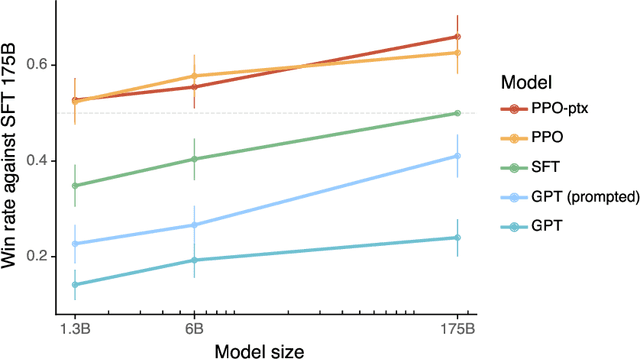
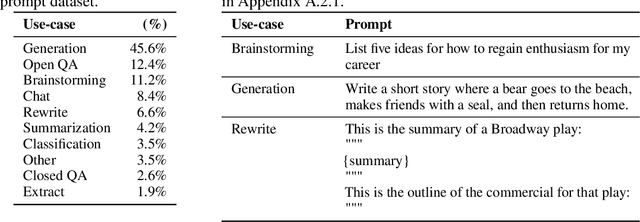
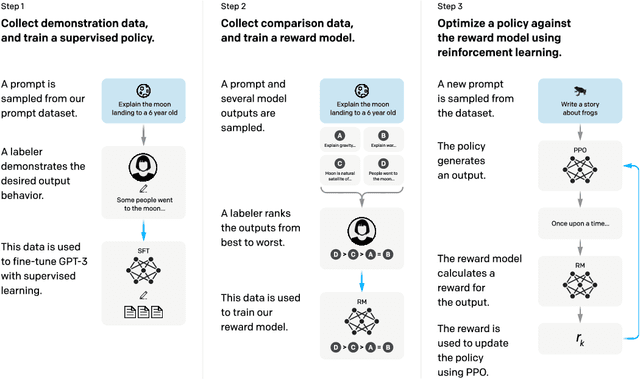

Abstract:Making language models bigger does not inherently make them better at following a user's intent. For example, large language models can generate outputs that are untruthful, toxic, or simply not helpful to the user. In other words, these models are not aligned with their users. In this paper, we show an avenue for aligning language models with user intent on a wide range of tasks by fine-tuning with human feedback. Starting with a set of labeler-written prompts and prompts submitted through the OpenAI API, we collect a dataset of labeler demonstrations of the desired model behavior, which we use to fine-tune GPT-3 using supervised learning. We then collect a dataset of rankings of model outputs, which we use to further fine-tune this supervised model using reinforcement learning from human feedback. We call the resulting models InstructGPT. In human evaluations on our prompt distribution, outputs from the 1.3B parameter InstructGPT model are preferred to outputs from the 175B GPT-3, despite having 100x fewer parameters. Moreover, InstructGPT models show improvements in truthfulness and reductions in toxic output generation while having minimal performance regressions on public NLP datasets. Even though InstructGPT still makes simple mistakes, our results show that fine-tuning with human feedback is a promising direction for aligning language models with human intent.
GLIDE: Towards Photorealistic Image Generation and Editing with Text-Guided Diffusion Models
Dec 22, 2021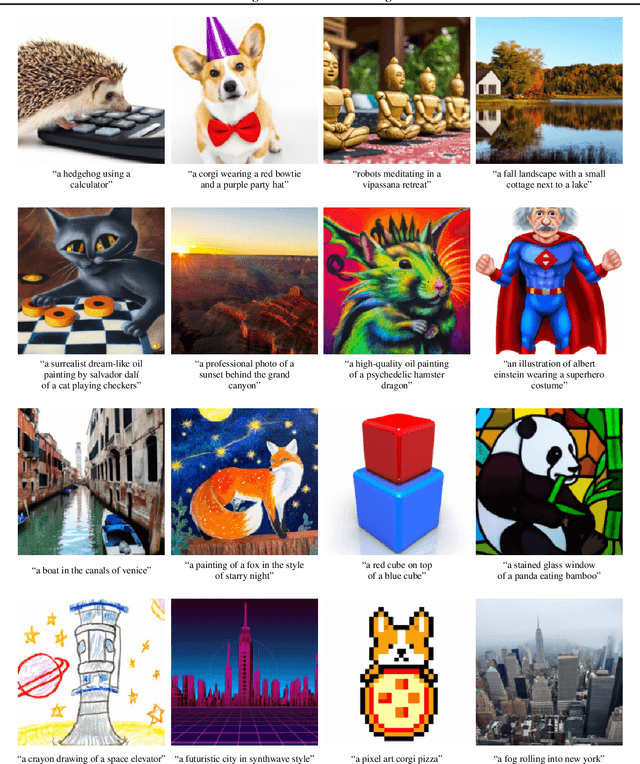

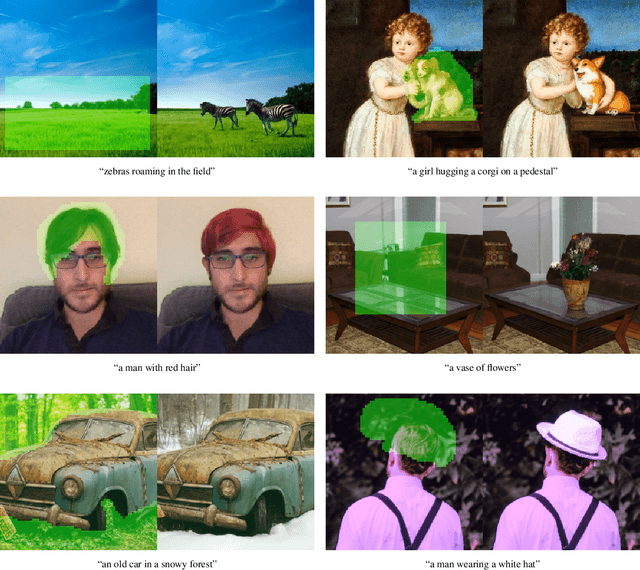
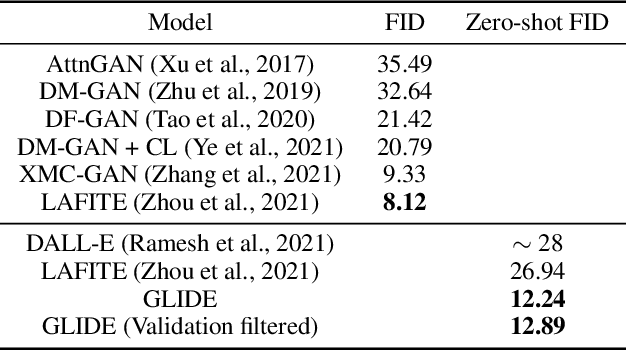
Abstract:Diffusion models have recently been shown to generate high-quality synthetic images, especially when paired with a guidance technique to trade off diversity for fidelity. We explore diffusion models for the problem of text-conditional image synthesis and compare two different guidance strategies: CLIP guidance and classifier-free guidance. We find that the latter is preferred by human evaluators for both photorealism and caption similarity, and often produces photorealistic samples. Samples from a 3.5 billion parameter text-conditional diffusion model using classifier-free guidance are favored by human evaluators to those from DALL-E, even when the latter uses expensive CLIP reranking. Additionally, we find that our models can be fine-tuned to perform image inpainting, enabling powerful text-driven image editing. We train a smaller model on a filtered dataset and release the code and weights at https://github.com/openai/glide-text2im.
Evaluating Large Language Models Trained on Code
Jul 14, 2021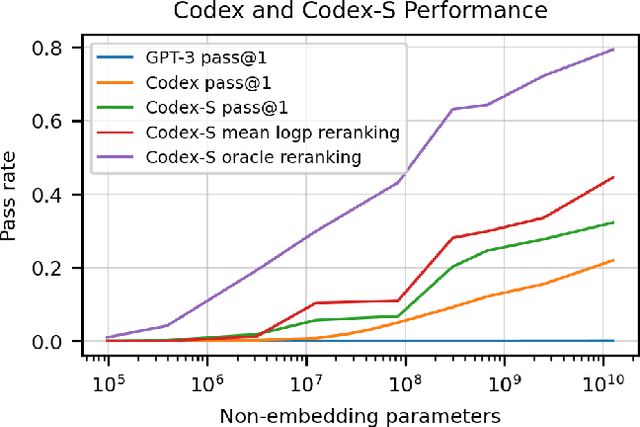
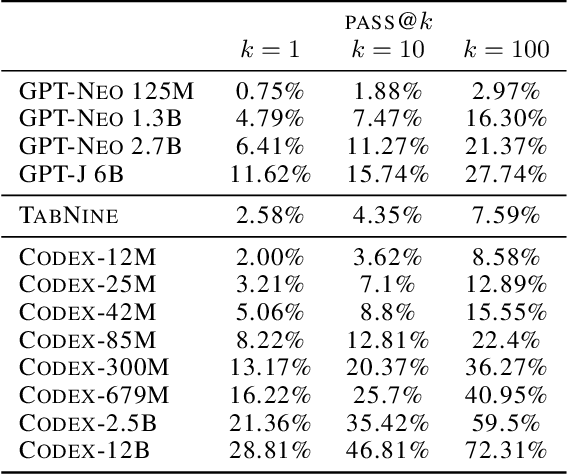
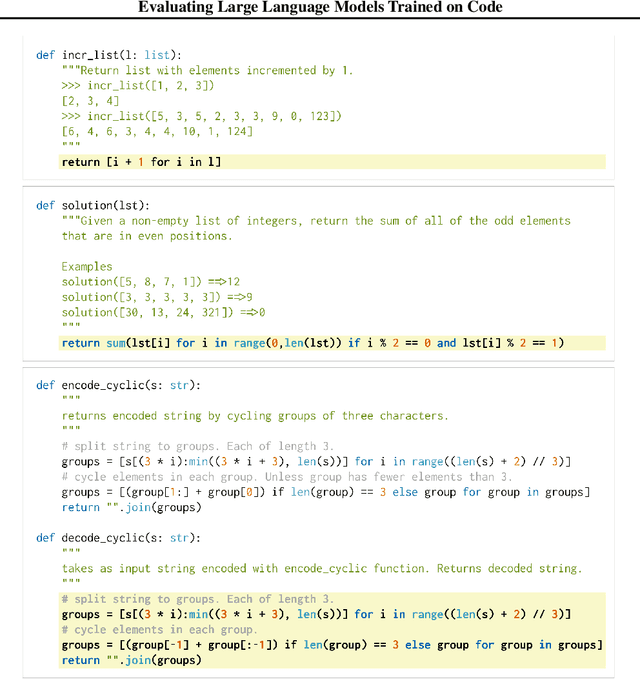

Abstract:We introduce Codex, a GPT language model fine-tuned on publicly available code from GitHub, and study its Python code-writing capabilities. A distinct production version of Codex powers GitHub Copilot. On HumanEval, a new evaluation set we release to measure functional correctness for synthesizing programs from docstrings, our model solves 28.8% of the problems, while GPT-3 solves 0% and GPT-J solves 11.4%. Furthermore, we find that repeated sampling from the model is a surprisingly effective strategy for producing working solutions to difficult prompts. Using this method, we solve 70.2% of our problems with 100 samples per problem. Careful investigation of our model reveals its limitations, including difficulty with docstrings describing long chains of operations and with binding operations to variables. Finally, we discuss the potential broader impacts of deploying powerful code generation technologies, covering safety, security, and economics.
Learning Transferable Visual Models From Natural Language Supervision
Feb 26, 2021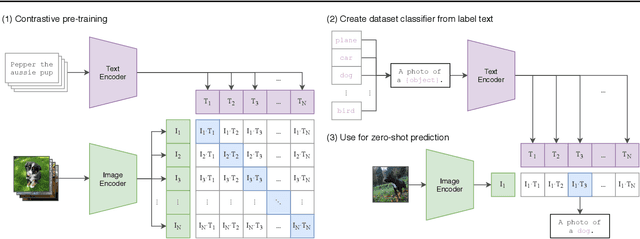

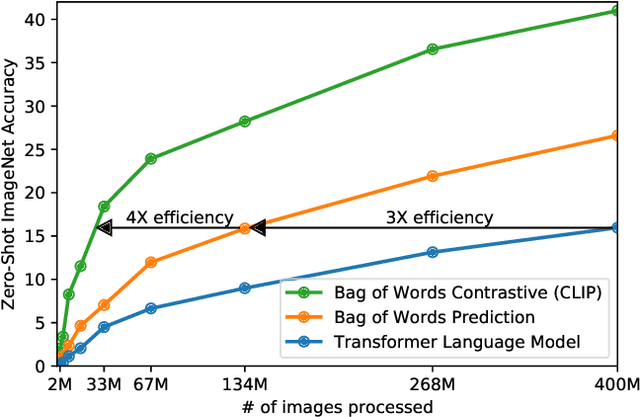

Abstract:State-of-the-art computer vision systems are trained to predict a fixed set of predetermined object categories. This restricted form of supervision limits their generality and usability since additional labeled data is needed to specify any other visual concept. Learning directly from raw text about images is a promising alternative which leverages a much broader source of supervision. We demonstrate that the simple pre-training task of predicting which caption goes with which image is an efficient and scalable way to learn SOTA image representations from scratch on a dataset of 400 million (image, text) pairs collected from the internet. After pre-training, natural language is used to reference learned visual concepts (or describe new ones) enabling zero-shot transfer of the model to downstream tasks. We study the performance of this approach by benchmarking on over 30 different existing computer vision datasets, spanning tasks such as OCR, action recognition in videos, geo-localization, and many types of fine-grained object classification. The model transfers non-trivially to most tasks and is often competitive with a fully supervised baseline without the need for any dataset specific training. For instance, we match the accuracy of the original ResNet-50 on ImageNet zero-shot without needing to use any of the 1.28 million training examples it was trained on. We release our code and pre-trained model weights at https://github.com/OpenAI/CLIP.
 Add to Chrome
Add to Chrome Add to Firefox
Add to Firefox Add to Edge
Add to Edge